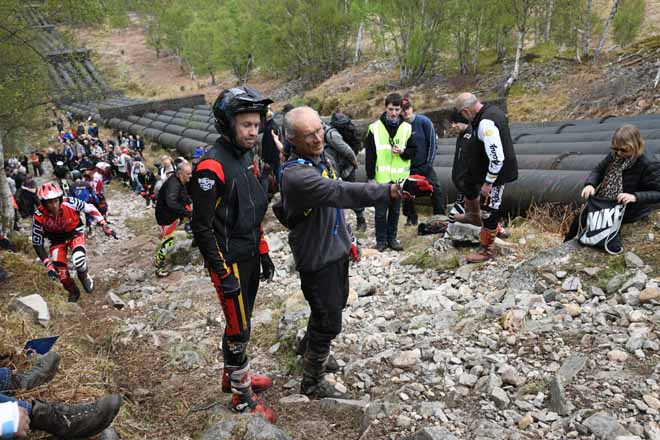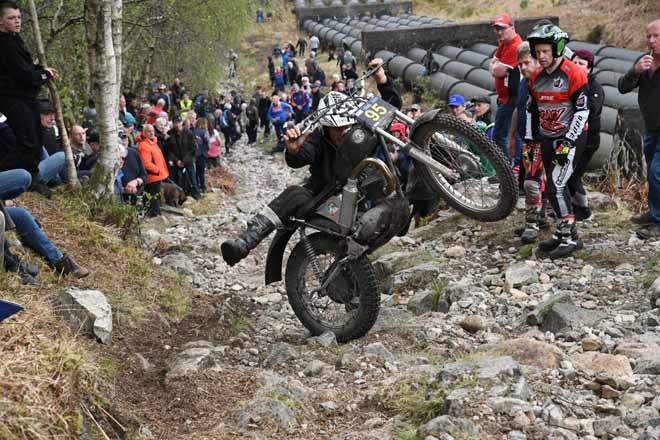29/07/22 - How many points must the winner of a race score?
One of the topical issues for those who organize it is finding the right difficulties to make the competition fun and at the same time selective for the participants. In the past there have been suppositions, arguments, even some have concluded with penalty formulas, depending on the number of zones
. For example: in order for a race to be considered well marked, there must be a winner who has made at least one dab on average for each section. How often has it been heard: "... too easy, if you take a five you never catch up ...".
Consequently, entering in the perspective of listening to winners eager for something more, some thrill that makes them go up in the andrenaline, the level of the sections has progressively raised, with dire consequences for the last of the class. These ones slowly abandoned the competitions and some even the Trial.
The trial market, on the other hand, needs them above all. Manufacturers need to be able to make ends meet with consistent sales. But the motorcycle clubs themselves, increasingly at loggerheads when it comes to taking stock after the organization of an event, must be able to count on massive participation.
Despite, the solution seems so simple: keep the level of the sections low. Where there are different levels, the discontented with the excessive banality of their class, will always be invited to level up.
We are talking about most of the amateur races, both of modern motorcycles, even more if we cross over into the field of vintage ones.
It is not scandalous that a rider wins a race, cleaning it. Let's not forget that Trial as a definition is a competition of skill and who is more skilled than that competitor capable of not making mistakes throughout the competition?
To demonstrate what has been said above, we bring you the example of two races: one of modern bikes and one of vintage: the Scottish Six Days and the Scottish Pre-65.
In the first, there was a slight increase in difficulties due to the evolution of motorcycles, okay, but a trifle if you compare it to the World Championship. In the second, none of this. Every year 200 drawn on the basis of 300 requests battle with zeros, because whoever wins turns to one or two. Yet none of the organizers ever thought of inserting a few more difficulties to get a more challenging selection.
In the vintage world, the rule of easy routes is even more valid and it is super successful. See how many pilots there are in France, Spain or Great Britain. For these competitors there is also the reason for not wanting to destroy motos, often the result of precious and expensive restorations.
The reasoning does not exclude that certain super-titled races see the World Championship or the National's for the highest categories, must follow other criteria, but these must not be taken as an example and overturn the choices on the classes that are the lifeblood of Trial. We have lost so many people on the street, let's not lose any more ...
Difficulty "softening" work is being done in Italy in vintage races; both in Group 5 of the FMI ( Italian Federation) and in the T.A.T.A. directed by ASI (Promotion Body), the input is to allow everyone to have fun.
Here, courtesy of John Hulme, UK Trial Magazine, the results and some photos, as well as an abundant video coverage of the two days of competition of this year's edition.
The full story of the 2022 Scottish Pre-65 is on the current issue of Trial Magazine Classic, click here.
---------------------------------------------------------------------------------------
A quanto deve girare il vincitore di una gara?
Una delle questioni sempre d'attualità per chi organizza è trovare le giuste difficoltà per rendere ai partecipanti la gara divertente e al tempo stesso selettiva. In passato si sono fatte supposizioni, ragionamenti, addirittura c'è chi ha concluso con formule di penalità, in funzione del numero di zone.
Ad esempio : affinchè si possa considerare ben traccata una gara deve esserci un vincitore che ha almeno posato un piede di media per ogni zona. Quanto spesso si è sentito dire: “...troppo facile, se fai un cinque non recuperi più ...”.
Di conseguenza, entrando nell'ottica di ascoltare vincitori desiderosi di qualcosa di più, di qualche brivido che faccia salire loro l'andrenalina, il livello delle zone si è progressivamento alzato, con conseguenze nefaste per gli ultimi della classe. Questi piano piano hanno abbandonato le competizioni e qualcuno addirittura il Trial.
Il mercato del Trial ha invece bisogno soprattutto di loro. I costruttori devono poter quadrare i loro conti con vendite consistenti. Ma i moto club stessi, sempre di più ai ferri corti quando si tratta di tirare le somme dopo l'organizzazione di un evento, devono poter contare su massive parteciazioni.
Eppure la soluzione sembra così semplice: tenere basso il livello delle zone. Laddove esistono diversi percorsi, gli scontenti per l'eccessiva banalità della loro classe, potranno sempre venir invitati a salire di livello.
Stiamo parlando della maggior parte delle gare amatoriali, sia di moto moderne, ancora di più se sconfiniamo nel campo di quelle d'epoca.
Non è scandaloso che un pilota vinca una gara, girando a zero. Non dimentichiamo che il Trial come definizione è una gara di abilità e chi è più abile di quel concorrente capace di non commettere errori in tutta la gara?
A dimostrazione di quanto finora affermato vi portiamo l'esempio di due gare: una di moto moderne e una d'epoca: la Sei Giorni di Scozia e la Scottish Pre-65.
Nella prima c'è stato un lieve aumento delle difficoltà dovuto all'evoluzione delle motociclette, d'accordo, ma un'inezia se lo si paragona al Campionato del Mondo. Nella seconda niente di tutto questo. Ogni anno 200 sorteggiati sulla base di 300 richieste si danno battaglia a suon di zeri, perchè chi vince gira a uno o due. Eppure a nessuno degli organizzatori è mai venuto in mente di inserire qualche difficoltà in più per ottenere una maggiore selezione.
Nel mondo d'epoca ancora di più vale la regola di percorsi facili ed è super vincente. Si veda quanti sono i piloti in Francia, Spagna o Gran Bretagna. Per questi concorrenti si aggiunge la ragione di non voler distruggere cavalcature, spesso frutto di preziosi e costosi restauri.
Il ragionamento non esclude che certe gare supertitolate vedi il Mondiale o l'Italiano per le categorie più alte, debbano seguire altri criteri, ma queste non devono essere prese come esempio e ribaltare le scelte sulle classi che sono la linfa del Trial. Abbiamo perso tanta gente per strada, non perdiamone altra …
Un lavoro di “addolcimento” difficoltà si sta facendo in Italia nelle gare d'epoca; sia nel Gruppo5 della FMI, sia nel T.A.T.A . di regia ASI, l'input è quello di permettere a tutti di divertirsi.
Ecco, per la gentilezza di John Hulme, UK Trial Magazine, i risultati e alcune foto, nonchè un'abbondante copertura video dei due giorni di gara dell'edizione di quest'anno.
L'articolo completo della 2022 Scottish Pre-65 si trova sul numero corrente di Trial Magazine Classic, cliccate qui.
------------------------------------------------------------------------------------------
----> RISULTATI GIORNO UNO
----> RISULTATI TOTALI
----> PREMIATI
------------------------------------------------------------------------------------------
------------------------------------------------------------------------------------------
---------------------------------------------------------------------------------------











---------------------------------------------------------------------------------------

